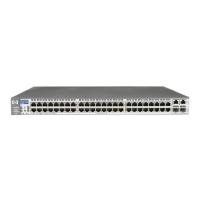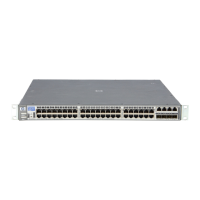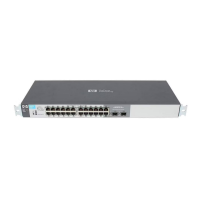Configuring the Switch Modules using the Menu-driven Interface
Configuring VLANs
A Virtual Local Area Network (VLAN) is a network topology configured according to a
logical scheme rather than the physical layout. VLANs can be used to combine any collection
of physical LAN segments into an autonomous user group that appears as a single LAN.
VLANs also logically segment the network into different broadcast domains so that logical
packets are forwarded only between ports within that VLAN. Typically, a VLAN
corresponds to a particular subnet, although not necessarily. VLANs can enhance
performance by conserving bandwidth, and improve security by limiting traffic to specific
domains.
The switch module supports only port-based IEEE 802.1Q tag-capable VLANs.
VLAN membership for each port can be set as follows:
•
•
Egress Port—This is a port on the interconnect switch that belongs to at least one
VLAN. By default all ports are egress members of DEFAULT_VLAN.
— Untagged Member—Ports that are untagged members of a VLAN participate in the
VLAN, but no tag is associated to the packet when leaving that port. Untagged
member ports can only be a member of one VLAN at a time.
— Tagged Member—Ports with tagging enabled will insert the IEEE 802.1Q tag with
the VID number into all packets that flow out of it. Tagged member ports can be
members of multiple VLANs at a time, as packets are tagged with the VLAN ID
from which they originated. Tagged member ports link IEEE 802.1Q trunks that
work as inter-switch connections to forward packets belonging to multiple VLANs,
to which those tagged member ports belong. If a packet has been tagged, the port
does not alter the packet, thus keeping the VLAN information intact. The VLAN
information in the tag can then be used by other 802.1Q compliant devices on the
network to make packet-forwarding decisions.
Forbidden Non-member—These ports are not a member of the VLAN and are also
forbidden from joining a VLAN dynamically when GVRP is enabled.
If ingress filtering is enabled for a port, the interconnect switch examines the VLAN
information in the packet header (if present) and decides whether or not to forward the
packet. The VID should match the PVID of that port, otherwise, that incoming packet is
discarded.
Packets cannot cross VLANs. If a member of one VLAN wants to connect to another VLAN,
it must do so through a router.
Default VLAN
The switch module reserves one VLAN, VID 1, also called DEFAULT_VLAN. The factory
default setting assigns all ports on the switch module to the default VLAN. As new VLANs
are configured, their respective member ports are removed from the default VLAN.
2-26 HP ProLiant BL e-Class C-GbE Interconnect Switch Menu-driven Interface Reference Guide
HP CONFIDENTIAL Codename: DeLorean Part Number: 322858-001 Last Saved On: 2/4/03 11:56 AM

